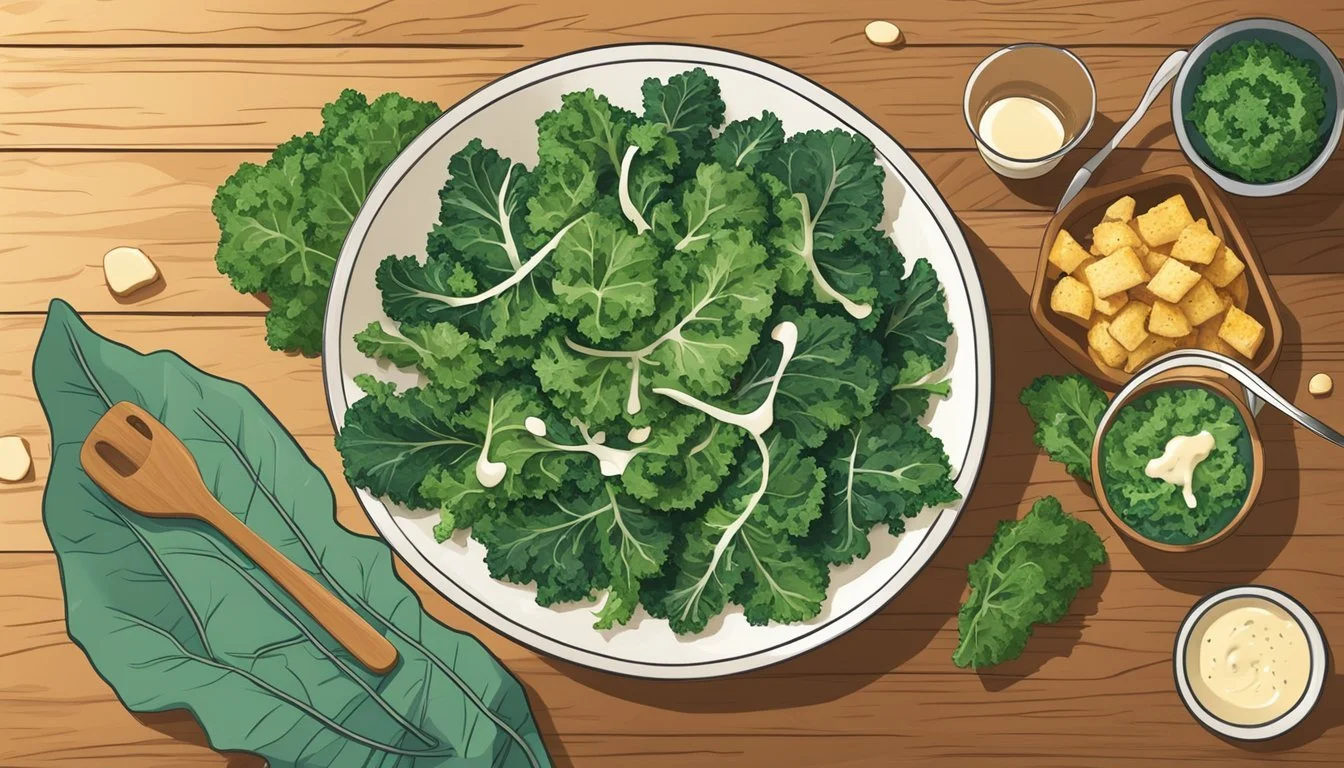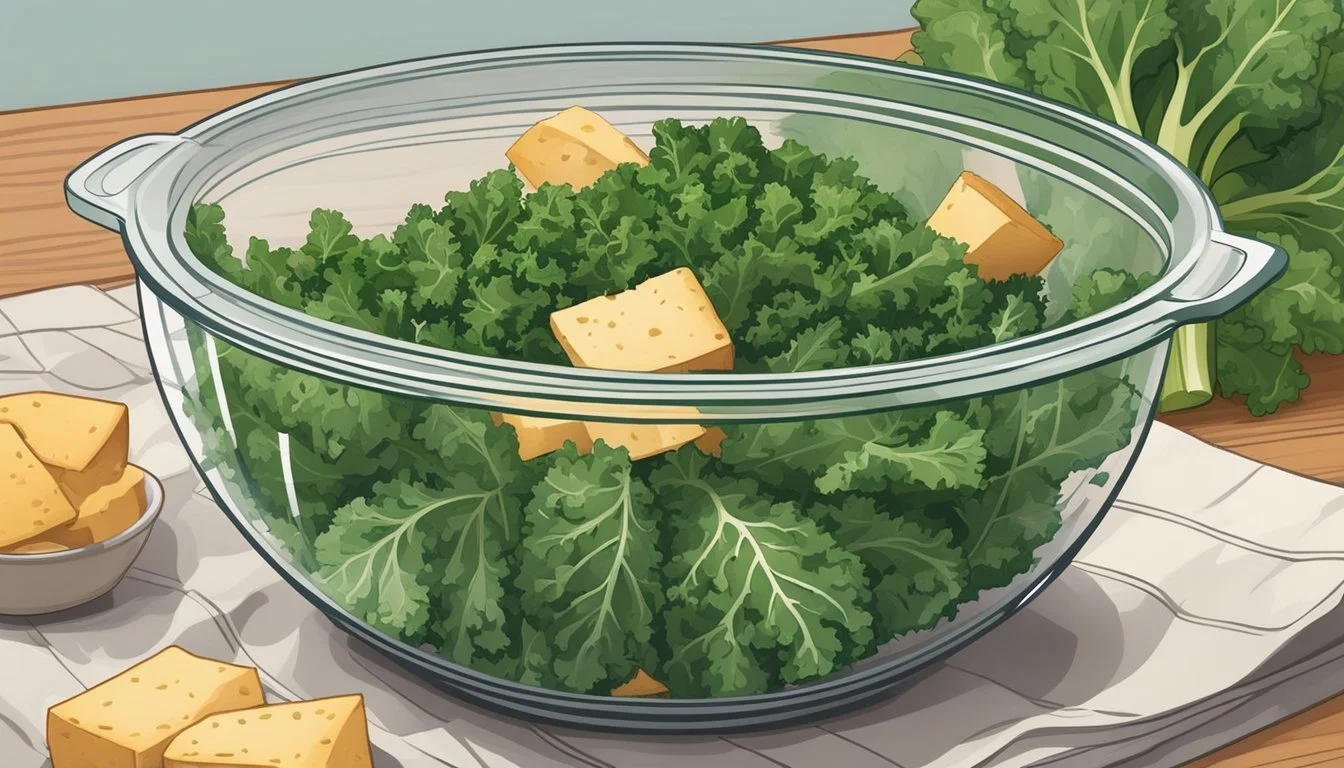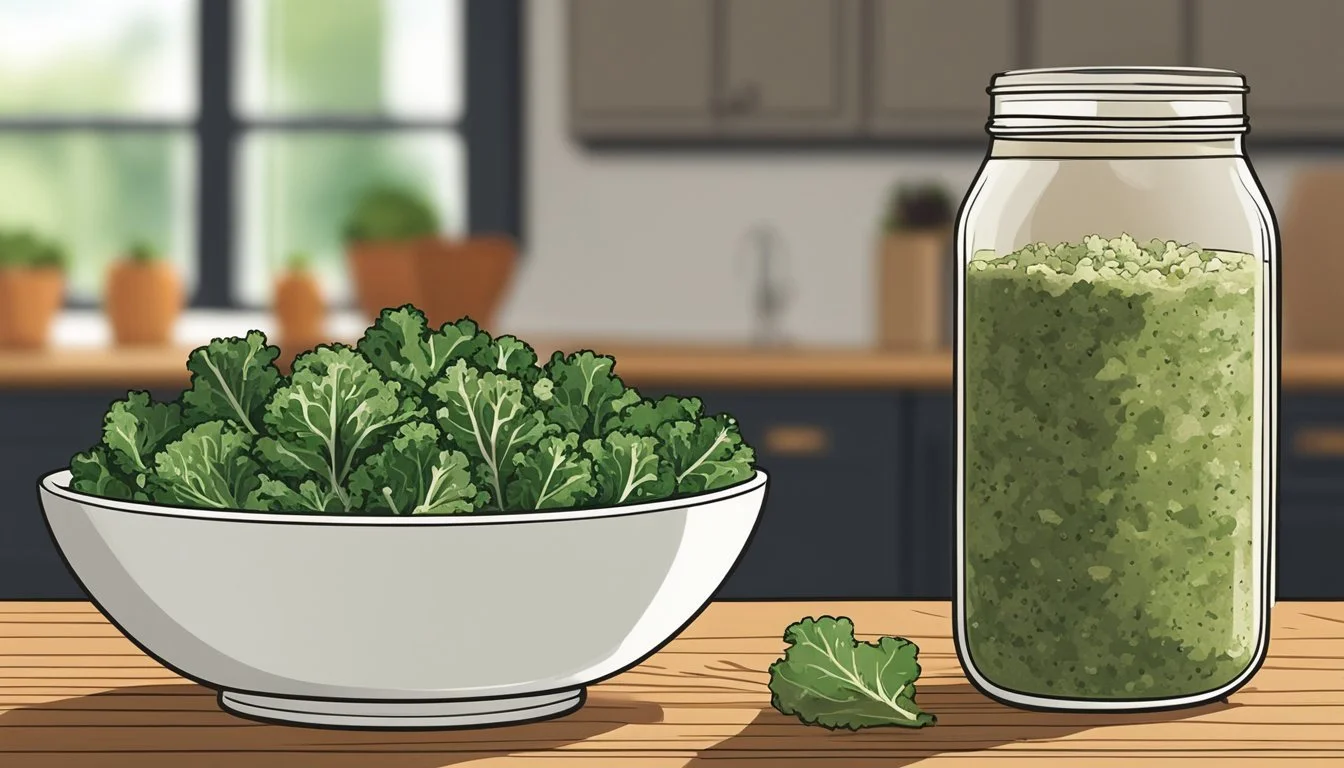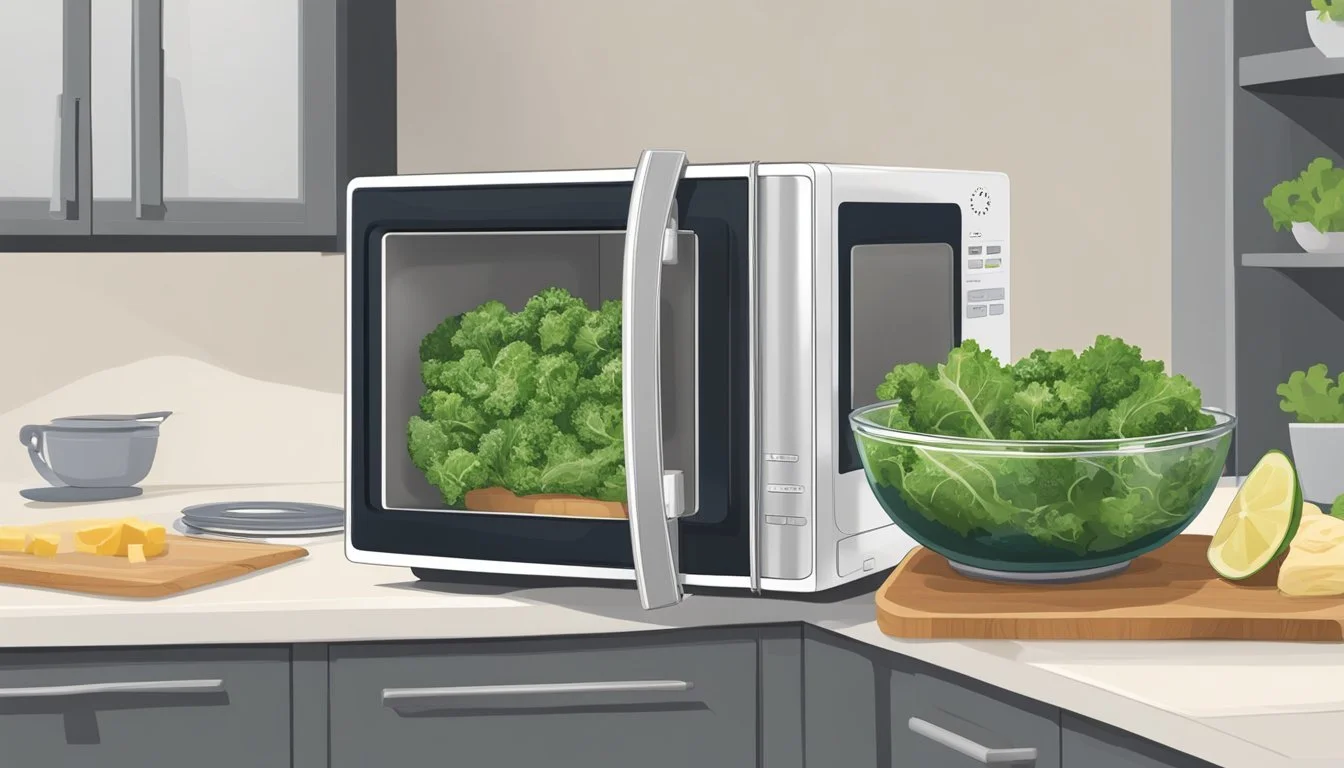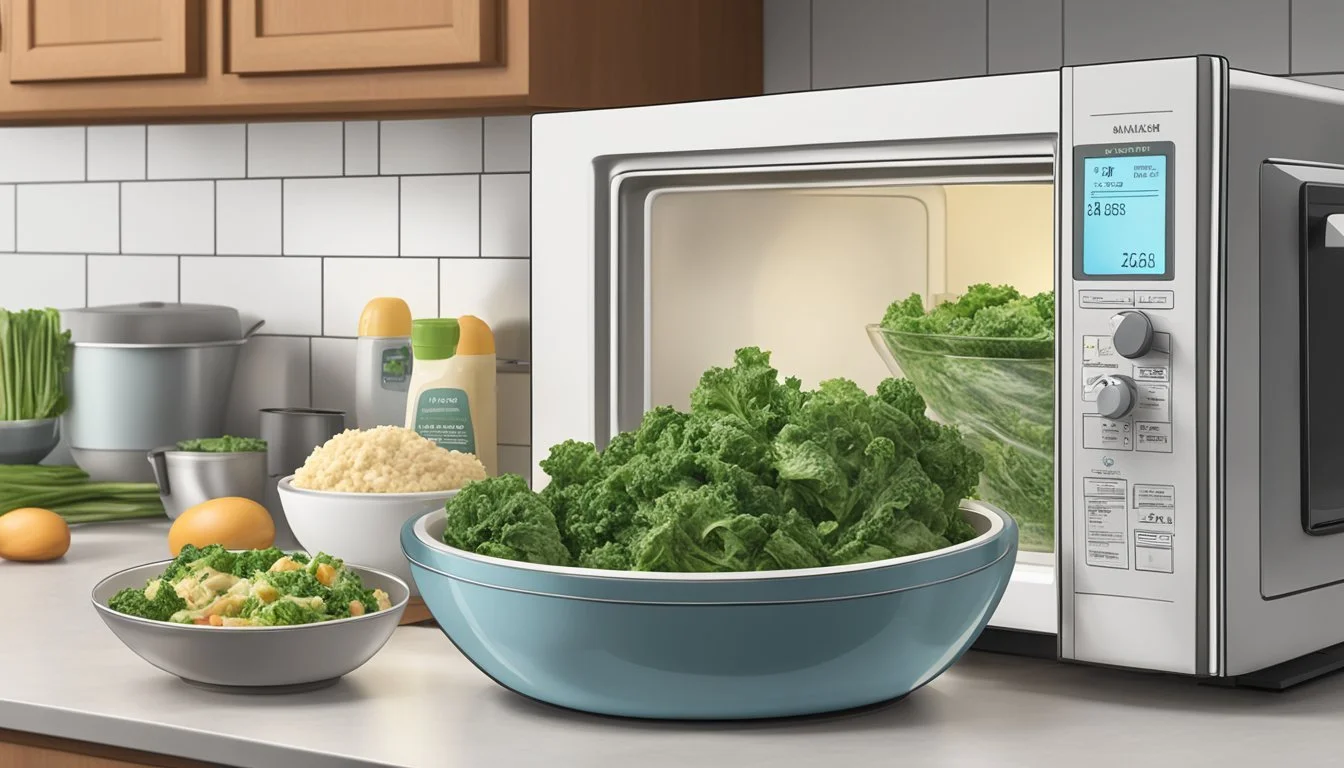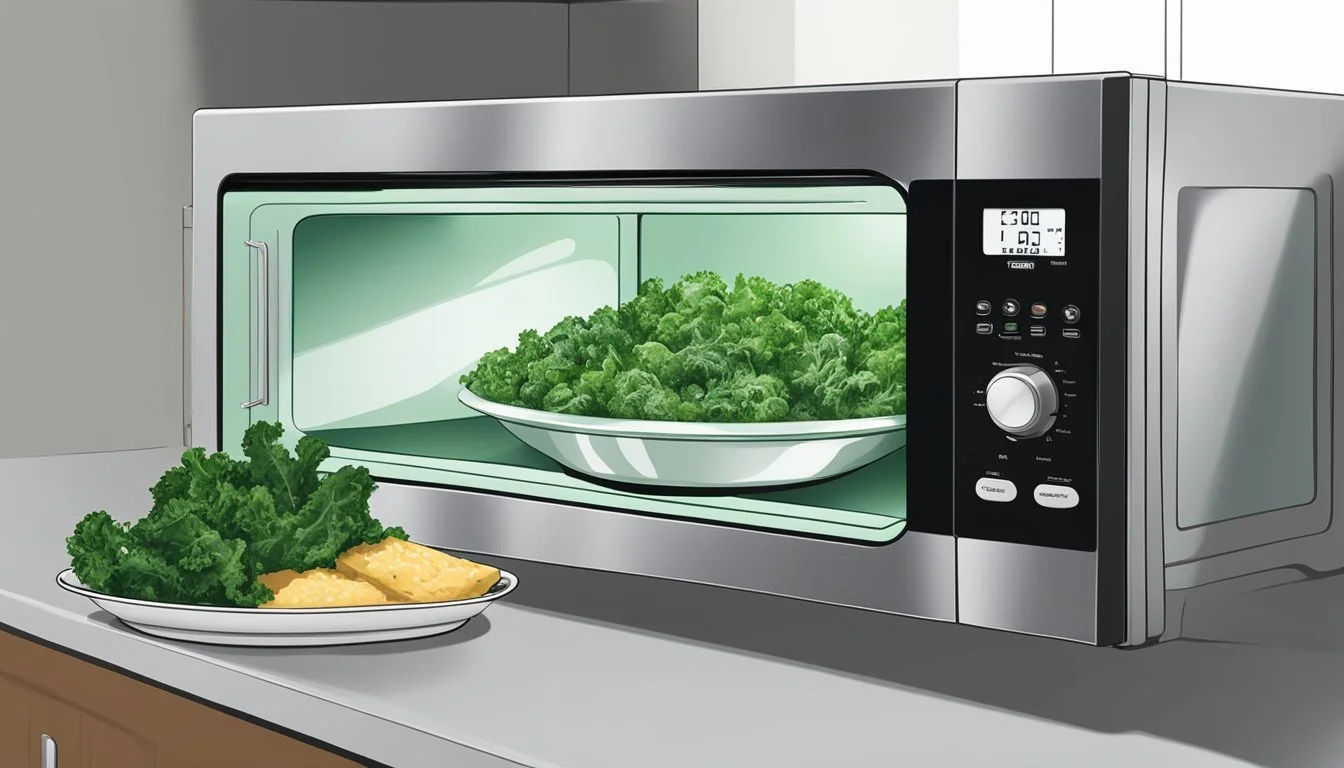Best Way to Reheat Kale Caesar Salad
Keeping Your Greens Crisp and Fresh
Reheating a kale Caesar salad while preserving its crisp texture can be a culinary challenge. Kale, a robust green known for its hearty texture, typically stands up well in salads (What wine goes well with salads?), and a Caesar salad specifically benefits from a fresh, crunchy quality in the greens. However, when it comes to reheating this dish, the key is to focus on warming the individual components that can handle heat without compromising the integrity of the greens.
Components such as chicken, tempeh, or chickpea croutons are frequently added to enhance the protein content and textural variety of kale Caesar salads, making them a complete meal. When reheating, these protein elements and croutons should be warmed separately to maintain their desired crispness. This method ensures that the kale retains its fresh, crunchy texture, and that the overall quality of the salad is not diminished by exposure to excessive heat.
Maintaining the balance between a warm, inviting meal and the characteristic texture of a Caesar salad requires careful attention to detail. One must avoid the wilting or sogginess that can occur if the kale is reheated improperly. By treating each component with care, the integrity of a kale Caesar salad's texture and the vibrancy of its flavor can be preserved, even upon reheating.
Understanding Kale Caesar Salad
Kale Caesar Salad merges the traditional flavors of a classic Caesar salad with the nutritional benefits of kale. This combination results in a dish that is both familiar and distinctly nutritious, fitting well into modern dietary preferences.
History of Caesar Salad
The Caesar salad was originally created in 1924 by Caesar Cardini, an Italian immigrant who owned restaurants in Mexico and the United States. Cardini’s classic Caesar salad was a simple mixture of romaine lettuce, croutons, parmesan cheese, lemon juice, olive oil, egg, Worcestershire sauce, garlic, and black pepper. Extraordinary in its simplicity and flavor, the salad gained rapid popularity.
Role of Kale in Caesar Salad
Kale offers a nutritious upgrade to the traditional Caesar salad. Its leaves are rich in vitamins A, K, C, and minerals such as iron and calcium, making it a powerhouse ingredient. There are multiple varieties, but curly kale is the most common in kale salads. When kale is incorporated into a Caesar salad, it not only boosts the nutritional profile but also transforms the texture, lending a hearty chewiness that complements the creamy Caesar dressing. This change has made it a modern favorite for health-conscious individuals who still seek the rich, savory flavors characteristic of a Caesar salad.
Ingredients Breakdown
To achieve the best reheated Kale Caesar Salad with a crisp texture, it's essential to understand the components. The quality and treatment of the kale, the blend of ingredients in the Caesar dressing, and the choice of additional salad elements all contribute to the final dish's success.
Kale Selection and Handling
When selecting kale for a Caesar salad, look for fresh, dark green leaves without any brown spots. Prior to reheating, kale should be stored properly, most ideally in a cool and dry place to maintain its crispness. It's also advisable to massage the kale with a bit of olive oil to tenderize it before adding any dressing.
Storage: In the refrigerator, wrapped in a paper towel and placed in an airtight bag.
Preparation: Massage with extra-virgin olive oil and a pinch of salt before layering on other ingredients.
Caesar Dressing Ingredients
A classic Caesar dressing involves a blend of anchovies, (What wine goes well with anchovies?) garlic, lemon juice, Dijon mustard, mayonnaise, or Greek yogurt to achieve a rich and tangy flavor profile. Use freshly grated parmesan cheese for the best quality.
Tang: Lemon juice adjusts acidity.
Seasoning: Minced garlic, salt, and pepper to taste.
Creaminess: Mayonnaise or Greek yogurt for texture.
Umami: Anchovies or anchovy paste and Dijon mustard for depth.
Fats: Extra-virgin olive oil for a smooth emulsion.
Additional Salad Components
Croutons provide a necessary crunch, a contrast to the softness of the kale even when reheated. For maintaining their texture, store them separately and add just before serving. Good croutons can be made by tossing bread pieces with olive oil, salt, and pepper, and then baking until golden. Lastly, additional parmesan cheese can be added as a garnish, providing a salty and nutty flavor, and enhancing the salad's overall appeal.
Croutons: Stored separately to preserve crispness.
Parmesan: Freshly shaved or shredded for garnishing.
Preparing the Base Salad
To achieve the ideal texture of a kale Caesar salad, careful preparation of the kale is essential. Tenderizing the kale and creating a harmonious balance with other ingredients sets the foundation for a salad that retains its crispness when reheated.
Washing and Tenderizing Kale
Before combining ingredients, one should thoroughly wash the kale to remove any dirt or debris. After drying, they should tear or chop the kale leaves into bite-sized pieces. To tenderize, the kale can be massaged with a small amount of olive oil and a pinch of salt. This process should last several minutes, until the kale has softened and the texture has become more pliable.
Steps to Tenderize Kale:
Wash kale in cold water.
Dry thoroughly with a salad spinner or towel.
Tear or chop into bite-sized pieces.
Massage with olive oil and salt until soft.
Creating a Balanced Mix
To ensure every bite is flavorful, the kale must be evenly coated with Caesar dressing. This not only adds taste but also contributes to the salad's ability to maintain a pleasing texture upon reheating. Other ingredients like romaine lettuce can be added in equal proportion to the kale, creating a balanced mix that supports the overall structure of the salad.
Ingredients for a Balanced Mix:
Equal parts of kale and romaine lettuce.
Caesar dressing, proportionate to the amount of greens.
Optional: Additional salad elements such as croutons or protein, introduced after reheating to preserve their texture.
Homemade Dressings and Enhancements
Creating a homemade dressing is essential for a Kale Caesar Salad that retains its crisp texture. Dressings made from scratch not only offer a richer flavor but also give you control over the ingredients, ensuring freshness and quality.
Classic Caesar Dressing Preparation
The traditional Caesar dressing starts with the foundation of egg yolks, Dijon mustard, and Worcestershire sauce. To make a classic Caesar dressing:
In a blender or food processor, combine 2 egg yolks, 1 teaspoon Dijon mustard, and 1 teaspoon Worcestershire sauce.
Blend them together, slowly adding in ½ cup of olive oil to create an emulsion.
Season the dressing with kosher salt to taste and a squeeze of fresh lemon juice for acidity.
The flavor profile should be balanced, with a creamy texture that perfectly coats the kale leaves without weighing them down.
Alternative Dressing Variants
For those seeking a twist on the classic or adhering to dietary restrictions, alternative homemade dressings are a great option. A vegan Caesar dressing can be made using:
Vegan parm to replace traditional Parmesan cheese.
Silken tofu or cashews blended as a creamy base in lieu of egg yolks.
A vegan-friendly Worcestershire sauce.
Substitute traditional ingredients with these alternatives and follow a similar blending process. Adjust the seasoning with kosher salt and lemon juice. These variants should maintain the integrity of a Caesar while providing a different spectrum of flavors and textures.
Reheating the Kale Caesar Salad
When reheating a Kale Caesar Salad, the goal is to warm it gently without compromising the crisp texture of the kale and other ingredients, or the emulsification of the dressing.
Best Methods for Reheating
Microwave with Caution: If using a microwave, it should be on a low setting and in short bursts. They should transfer only the kale and heartier ingredients to a microwave-safe dish while ensuring to leave the dressing and more delicate additions, like croutons, aside.
Stovetop Method: Using a skillet on low heat can warm the kale and other robust elements. They should add just a touch of olive oil or water to prevent sticking and dryness. Continually tossing is key for even warmth.
Retaining Salad Freshness and Crispy Texture
Dressing on the Side: They should store the dressing separately to prevent the kale from becoming soggy. The dressing should be warmed up slightly, just enough to take the chill off, before adding it back to the greens.
Component Separation: Ingredients like croutons, parmesan, and roasted nuts should be kept at room temperature rather than reheated to preserve their essential crunch.
In reheating, maintaining the integrity of the salad's components is crucial for an enjoyable blend of warm, yet crispy, textures.
Storage and Meal Prep Tips
When it comes to enjoying a Kale Caesar Salad at its best, proper storage and advance preparation can make all the difference. The aim is to ensure that the salad remains fresh and the kale maintains its crisp texture when reheated.
Proper Salad Refrigeration
Storing the Salad:
In the Fridge: Place leftover Kale Caesar Salad in an airtight container to retain freshness. The ideal temperature for storing leafy greens in the fridge is between 32°F to 36°F.
Protein Additions: If your salad includes a protein such as chicken or tofu, store it separately to avoid sogginess in the kale and maintain optimal nutritional info preservation.
Key Tips:
Avoid Excess Moisture: Ensure the kale is as dry as possible before refrigeration to prevent wilting.
Paper Towel Technique: Line your storage container with paper towels to absorb any residual moisture.
Advance Preparation Strategies
Meal Prep Process:
Prep Time: Take time to wash, chop, and thoroughly dry the kale ahead of time. Store prepped kale in the fridge in a container lined with paper towels.
Cook Time: Prepare your proteins and additional salad components in advance and refrigerate them in separate containers.
Assembling the Salad:
Combining Elements: For the freshest experience, assemble the salad with dressing and toppings just before serving.
Dressing on the Side: Store your Caesar dressing in a separate container to avoid the kale becoming soggy.
Efficiency Tip:
Organize the refrigerator so that meal components are easy to access for quick assembly, thus reducing the overall time spent on weekday meal preparations.
Following these tips will help ensure your Kale Caesar Salad maintains its quality, making your meal prep both efficient and enjoyable.
Serving Suggestions
When reheating a Kale Caesar Salad, one must consider the best accompaniments to ensure the meal retains its allure. The right proteins and sides, along with the perfect garnishes, can make or break the experience.
Pairing with Proteins and Sides
Grilled Chicken: A classic protein choice, grilled chicken complements Kale Caesar Salad with its subtle smokiness and lean texture. It serves as a hearty counterpart to the greens.
Chickpeas: For a vegetarian boost of protein, chickpeas are a great addition. They can be served roasted for an added crunch.
Side Dish Options:
Grains: A side of quinoa or brown rice can make the meal more filling while preserving the salad’s crispness.
Vegetables: Steamed vegetables such as broccoli or asparagus make for a nutritious side that doesn't compete with the salad's flavors.
Presentation and Garnishes
Avocado: Slices of ripe avocado add creaminess to the salad, enhancing both the visual appeal and nutritional value.
Garnish Ideas:
Freshly shaved Parmesan cheese
Homemade croutons for added crunch
A lemon wedge to brighten the flavors before serving
Accompanyings like these not only add a distinct texture and flavor but also elevate the visual presentation of the dish, making it as attractive as it is delicious.
Nutritional Information and Dietary Adjustments
When reheating a Kale Caesar Salad, one should consider the nutritional profile of the dish and how it may vary with adjustments to suit dietary restrictions.
Calorie Counts and Nutrient Profiles
A standard serving of Kale Caesar Salad typically contains kale, Caesar dressing, croutons, and Parmesan cheese. The calories in a standard serving can range between 300 to 500 calories, largely influenced by the type and amount of dressing used. Nutritional content can be broken down as follows:
Calories: 300-500
Protein: High, from kale and cheese
Carbohydrates: Moderate, from croutons
Fats: High, primarily from the dressing
One could substitute Caesar dressing with a lighter option such as Greek yogurt-based dressing to reduce calorie intake while maintaining a creamy texture. Greek yogurt not only slashes calories but also adds beneficial probiotics and protein to the salad.
Customizing for Dietary Restrictions
To accommodate vegan diets:
Substitute Parmesan cheese with nutritional yeast or a vegan cheese alternative.
Ensure croutons are vegan, or make homemade croutons with vegan bread.
Opt for a vegan Caesar dressing, avoiding anchovies and egg yolks typically found in traditional recipes.
For those watching their total time spent on meal preparation:
Choose pre-washed and pre-cut kale to save time.
Ready-made vegan or Greek yogurt-based Caesar dressings can cut down preparation without compromising the nutritional quality.
By considering these adjustments, individuals can enjoy a reheated Kale Caesar Salad that suits their dietary needs without sacrificing taste or texture.
Beyond the Basics
This section navigates through innovative approaches to enhancing the traditional kale Caesar salad and introduces the concept of a build-your-own salad bar, elevating the salad experience.
Creative Twists on Traditional Caesar
Traditionally, a Caesar salad employs Romaine lettuce as its base, but in this rendition, kale stands in to provide a hearty texture and a nutritional boost. Chefs may impart an Italian flair by incorporating elements from an Italian chopped salad; think additions like arugula to add a peppery kick or cherry tomatoes for a touch of sweetness. When creating a unique kale Caesar salad recipe, consider these enhancements:
Arugula: Integrate for a complex flavor profile.
Cherry Tomatoes: Mix in for bursts of sweetness, complementing the creamy Caesar dressing.
The traditional recipe need not be confined to the classics. One might experiment with various greens, swapped or combined, to craft their signature take on this American favorite.
Building a Kale Caesar Salad Bar
For those hosting a gathering or simply aiming to personalize each plate, a salad bar presents a solution. Provide guests the components to assemble their own kale Caesar, ensuring both freshness and personal preference. A well-stocked salad bar might feature:
Greens: Kale, Romaine, Arugula
Proteins: Grilled Chicken, Anchovies, Tofu
Toppings: Parmesan, Croutons, Caesar Dressing, Cherry Tomatoes
Accents: Lemon Wedges, Freshly Ground Pepper
Organize the ingredients in a visually appealing manner and encourage diners to explore varying combinations to their liking, each building their ideal salad.
Conclusion
When reheating a Kale Caesar Salad to maintain its crisp texture, one must approach the task with precision. The goal is to warm the protein, such as chicken or tempeh, while preserving the fresh, leafy quality of the kale.
First, separate components of the salad. They should reheat proteins and croutons on a sheet tray in an oven preheated to 350°F for about 5-10 minutes, until just warmed through. This method ensures no sogginess is introduced.
Regarding the kale, massage it with a bit of olive oil if it's not already dressed, to avoid wilting when adding warm elements. Instead of reheating, one could opt for room temperature elements or slightly chilled, depending on preference.
Reheating Component Method / Temperature Time Proteins (Chicken/Tempeh) Oven / 350°F 5-10 min Croutons Oven / 350°F 5 min
Lastly, for those wanting to share their meal on platforms like Instagram, remember that presentation matters. Reassemble the salad carefully: lay down the kale, add the warmed protein and croutons, and drizzle with dressing if separate. The contrast of leafy greens and the glisten of dressing paired with a well-composed photo can elevate any meal from simple to Instagram-worthy.
In reheating a Kale Caesar Salad, the diner can enjoy a dish that is both warm and refreshingly crisp, suitable for a standalone meal that doesn't forsake the textural contrast that defines a Caesar salad.


